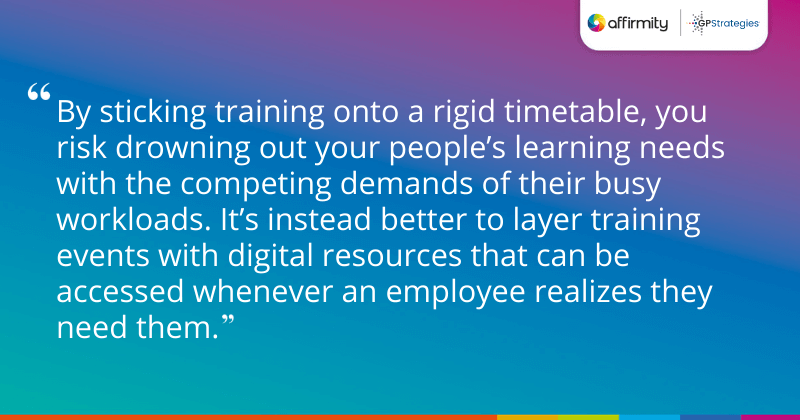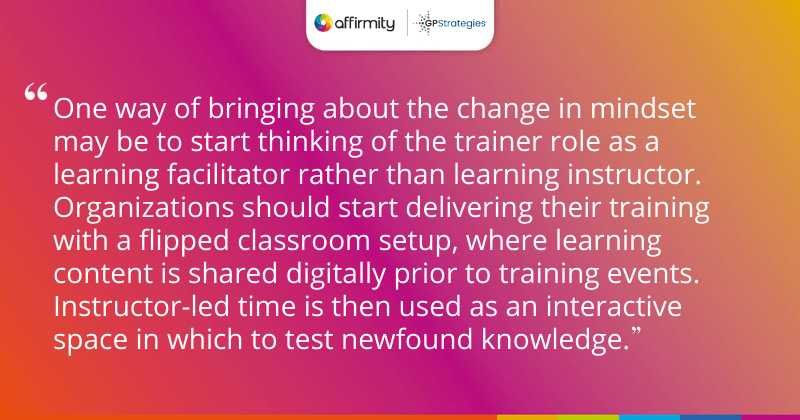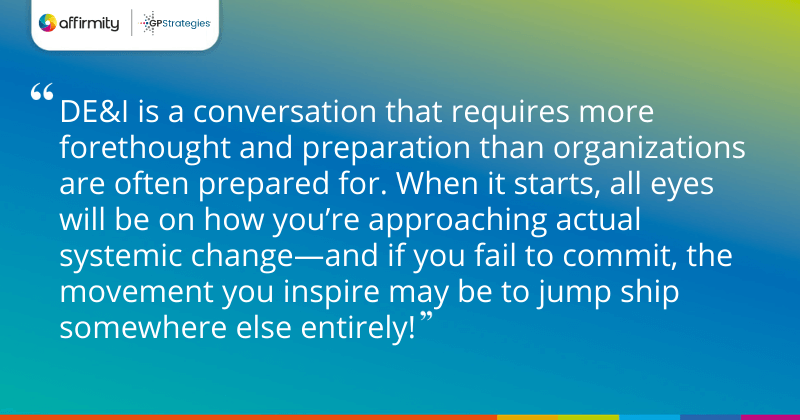The pace of change means that every aspect of a business needs modernization sooner or later, and your diversity, equity, and inclusion strategies are no exception. In this article, Nic Girvan, Global Director of Learning and Delivery at GP Strategies (an Affirmity inclusion training partner) helps you weed out obsolete training methods, content, and beliefs that could be harming rather than helping your efforts.
It takes significant effort to ensure that corporate training of all forms remains relevant. In the context of DE&I training, the evolving needs and concerns of your workforce are poorly served by sterile slides, outdated definitions, and clichéd diagrams (like an iceberg infographic!). Letting go of yesterday’s learning templates and fully redefining your approach may be key to engaging your people in the days and years ahead. Here are five of the best ways to start on the right path:
1. Know Why You’re Rolling Out Your Training

When DE&I challenges are identified, inclusion training often gets proposed as the supposedly obvious cure-all. However, no inclusive culture has ever been built by a one-off training event.
Think back to your organization’s most recent DE&I training effort. What was the motivation for that training? How did it address your operational and systematic evolution? In the absence of an agenda to achieve these objectives, your attempts could end up being labeled as “trivial” or “insensitive”. This can obviously be self-destructive when your objective is to inspire your employees.
When the need for DE&I training is first identified, it’s important to take some time to consider how you plan to transform insight into action. Inclusion training must be focused and practical, and it must also be tied to a change agenda. This will help your workforce adapt to new behavioral and organizational practices consciously.
DE&I is a conversation that requires more forethought and preparation than organizations are often prepared for. When it starts, all eyes will be on how you’re approaching actual systemic change—and if you fail to commit, the movement you inspire may be to jump ship somewhere else entirely!
MORE FROM THE BLOG | ‘3 Key Ways Employee Resource Groups Are Improving Global Organizations’
2. Stop Ticking Boxes—Commit to Continuing
Training in a corporate setting is often about “gained compliance”, and this approach can sometimes leak into DE&I training philosophy. An employee takes a course, this ticks a box, and they’ve attained compliance for the year ahead. There’s a finality to “compliance” that runs counter to the spirit of DE&I work. In reality, participation in training is really just the first step: true success is measured in marked behavioral change, and adult learners need to apply learning practically.
It’s been theorized that behavioral change is highly dependent on the practices and intentions of our peers. Intention to change requires both a strongly positive attitude and others with whom we can model the desired behaviors. It’s therefore essential that inclusion training efforts are measured not by a single sign-off event, but by an ongoing series of check-in efforts over the course of a year. This requires a fully realized learning pathway focused on practical application that, in turn, demands time investment and commitment from all of your employees.
3. Use Flipped Classroom Principles and Find Hidden Expertise

Your training methods must account for the fact that your learners are all adults, and for the changing expectations of learners in general. Adults expect to learn via critical thinking, problem-solving, and collaboration—but they also increasingly expect approaches that account for remote and hybrid learners.
One way of bringing about the change in mindset may be to start thinking of the trainer role as a learning facilitator rather than learning instructor. Organizations should start delivering their training with a flipped classroom setup, where learning content is shared digitally prior to training events. Instructor-led time is then used as an interactive space in which to test newfound knowledge—rather than the traditional two-hour knowledge dump.
This structure better allows for subject matter experts to share their expertise, while allowing learners to experience the topic at their own pace. The emphasis in your “classroom” can be on practical application for both facilitators and peers because learners arrive after having time to research and digest new information.
FURTHER THOUGHTS ON FLIPPED CLASSROOMS | ‘4 Steps to Help You Flip Your Classroom and Shake Up Your Inclusion Training’
4. Don’t Retreat From the Emotions in the Room
There’s a tendency for DE&I training to adopt an impartial and detached tone and to work to de-emphasize emotions. Part of the rationale behind this approach is that logic and practical application are essential for behavioral change. However, denying the validity of the emotional discomfort that DE&I topics can conjure can be counter-productive.
Training must instead tackle these issues head-on—the realities in the room must be unpacked. It’s essentially impossible for learners to get away from the always-on nature of news and social media. Individuals may be triggered by bias training, and even feelings of guilt can bring anyone in a position of privilege to a feeling of powerlessness.
Emotions can both impede and motivate adult learners. The emotional health required for DE&I change must be acknowledged, and training must be built with the goal of inspiring intrinsic motivation for facing DE&I challenges—we can’t simply tell adult learners how to act or how to think.
START CHALLENGING BIASES | ‘4 Areas You May Not Have Considered When Mitigating Hiring Bias’
5. Offer Learning at the Point of Need

From finding out where else you’ve seen a certain actor in a film you’re watching, to looking up a how-to on solving a DIY issue in your home, everyone is used to getting answers to their questions within seconds. By sticking training onto a rigid timetable, you risk drowning out your people’s learning needs with the competing demands of their busy workloads. It’s instead better to layer training events with digital resources that can be accessed whenever an employee realizes they need them.
Consider when DE&I questions are typically raised for your learners—there could be an interaction with a colleague or member of the public, or perhaps an event in local or national news that causes them to question what they know. Robust, just-in-time learning resources are most effective when they’re available to be accessed as required in an easily digestible format (i.e. microlearning) that focuses only on the most relevant information.
Start expertly combining digital, virtual, and face-to-face DE&I learning solutions to cultivate engagement and curiosity in your learners. Contact us today.
A version of this article originally appeared on Training Industry.
 About the Author
About the Author
Nic Girvan is the Global Director of Learning and Delivery at GP Strategies. She’s an expert in business psychology, adult learning practice, modern leadership, and DE&I transformation. In her role, she emphasizes that it’s only possible for organizational development strategies to result in measurable change when innovative and enhanced methods of delivery are fully embraced.
